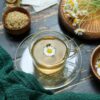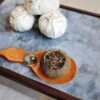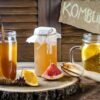
From a multitude of herbal infusions that have graced the world with their presence, chamomile tea stands out for its unique flavor and plethora of health benefits. It’s a beverage that has been consumed for centuries, transcending borders and cultures, earning its place as a staple in many households worldwide. With its calming properties and gentle flavor, chamomile tea has become a go-to drink for both relaxation and health promotion.
The beauty of chamomile tea lies not just in the soothing experience of consuming it, but also in its fascinating history, its diverse uses, and the therapeutic benefits it provides. It’s more than just a beverage; it’s a drink steeped in tradition, offering a moment of tranquility in our fast-paced lives.
This article serves as an ultimate guide to chamomile tea, delving into its origins, understanding its nature, exploring its uses, and highlighting its benefits. It’s a journey into the world of this remarkable herbal tea, offering insights that might just make you appreciate your next cup of chamomile tea even more.
The History and Origin of Chamomile Tea
Chamomile tea’s history is as rich and intriguing as its flavor. It originates from the chamomile plant, which has been recognized and utilized for its medicinal properties since ancient times. The term ‘chamomile’ is derived from the Greek words ‘chamos’ and ‘milos’, meaning ‘ground apple’, indicative of its apple-like scent.
The use of chamomile is deeply entrenched in the annals of ancient civilizations. Egyptians revered it as a gift from their god of the sun, utilizing it in traditional medicine, cosmetics, and even embalming oils. Romans, too, incorporated chamomile in beverages, incense, and medicinal applications. Greek physicians prescribed it for fevers and female disorders, acknowledging its healing properties early on.
The Middle Ages saw chamomile being used in beer brewing before hops became popular. Fast forward to modern times, and chamomile tea has become a global phenomenon, enjoyed by tea enthusiasts for its soothing properties and delightful taste.
Understanding Chamomile Tea: What Exactly is it?
Chamomile tea is a herbal infusion made from the dried flowers of the chamomile plant. There are two common types of chamomile used for tea: German chamomile (Matricaria recutita) and Roman chamomile (Chamaemelum nobile).
German chamomile is the most commonly used variety for tea due to its high concentration of essential oils. It grows wild in Europe and Asia and is cultivated for commercial use in several countries. Roman chamomile, on the other hand, is native to Western Europe and North Africa.
Chamomile tea is light golden in color with a fruity, floral flavor that is often likened to apples. It’s caffeine-free, making it a perfect choice for those seeking a calming, relaxing drink that can be enjoyed at any time of the day.
Different Types of Chamomile Tea
There are various ways to enjoy chamomile tea, each offering a unique flavor profile and experience. The most common type is the classic chamomile tea, made by infusing dried chamomile flowers in hot water. This produces a mildly sweet, floral brew with a hint of apple.
Then there are chamomile blends, where chamomile is paired with other herbs or flavors. Chamomile mint tea is a popular variant, offering a refreshing twist to the classic. Chamomile and lavender tea is another delightful blend, combining the calming properties of both herbs.
Chamomile can also be found in mixed herbal teas, often paired with herbs like lemongrass, rosehips, or hibiscus. These blends offer a complex flavor profile and additional health benefits.
The Process of Making Chamomile Tea
The process of making chamomile tea begins with the harvesting of chamomile flowers. The flowers are handpicked when they are fully bloomed, usually in the morning after the dew has evaporated. They are then dried naturally or using a dehydrator to preserve their flavor and medicinal properties.
To brew chamomile tea, the dried flowers are steeped in hot water for about 5 to 10 minutes. The longer the steeping time, the stronger the flavor. After steeping, the tea is strained to remove the flowers and is then ready to be enjoyed.
Making chamomile tea at home is a simple process that requires just dried chamomile flowers and hot water. However, the quality of the chamomile and the water used can significantly impact the final flavor of the tea.
The Various Uses of Chamomile Tea
Chamomile tea isn’t just for drinking. Its uses extend far beyond a comforting beverage. In skincare, chamomile tea can soothe skin irritations and promote a healthy complexion. A chamomile tea rinse can brighten blonde hair naturally.
In the home, a pot of brewing chamomile tea can act as a natural air freshener. Gardeners also use chamomile tea as a natural treatment for plant diseases.
In the culinary world, chamomile tea is used to flavor dishes like soups and desserts. Its subtle apple-like flavor can add a unique twist to traditional recipes.
Health Benefits of Chamomile Tea
Chamomile tea is more than a delightful beverage; it’s a potent herbal remedy. It’s been used in traditional medicine for centuries, and modern research supports many of these health claims.
One of the most well-known benefits of chamomile tea is its ability to promote sleep and relaxation. It’s often recommended as a natural treatment for insomnia and anxiety.
Chamomile tea is also known for its digestive benefits. It can soothe stomach aches, reduce indigestion, and ease symptoms of irritable bowel syndrome (IBS). Its anti-inflammatory properties can help with conditions like arthritis and can even soothe menstrual cramps.
Moreover, chamomile tea is packed with antioxidants, which can boost your immune system and protect against chronic diseases like cancer and heart disease.
How to Brew the Perfect Cup of Chamomile Tea
Brewing the perfect cup of chamomile tea involves more than just steeping flowers in hot water. The water temperature, steeping time, and the amount of chamomile used can all affect the taste and potency of the brew.
Start by bringing water to a boil. Then, add about one tablespoon of dried chamomile flowers for every cup of water. Pour the hot water over the chamomile flowers and let it steep for about 5 to 10 minutes, depending on your taste preference. Once steeped, strain the tea to remove the flowers.
For added flavor, you can sweeten your chamomile tea with honey or add a squeeze of lemon for a refreshing twist.
Where to Buy High-Quality Chamomile Tea
Finding high-quality chamomile tea is crucial for enjoying its full flavor and health benefits. Look for organic chamomile tea, as it’s free from pesticides and other harmful chemicals.
Many health food stores and supermarkets carry chamomile tea, both in loose leaf form and in tea bags. Online tea shops also offer a wide variety of chamomile teas, often providing detailed information about the source and quality of their products.
When buying chamomile tea, check the ingredients list to ensure you’re getting pure chamomile. Some brands may mix chamomile with other herbs or fillers, which can dilute the flavor and potency of the tea.
Is Chamomile Tea Right for You?
Whether you’re a seasoned tea enthusiast or a beginner exploring the world of herbal teas, chamomile tea offers a unique experience. It’s a soothing, flavorful beverage with a rich history and a wide range of uses and health benefits.
However, as with any herbal remedy, it’s essential to consider your health and individual needs. While chamomile is generally safe for most people, some may be allergic to it, particularly those who are allergic to plants in the daisy family.
If you’re considering adding chamomile tea to your routine, it may be worth consulting with a healthcare professional to ensure it’s the right choice for you.
In conclusion, chamomile tea is more than just a comforting beverage. It’s a cup of history, a soothing remedy, a culinary ingredient, and a testament to the power of nature. So why not steep a cup today and experience the wonders of chamomile tea for yourself?






